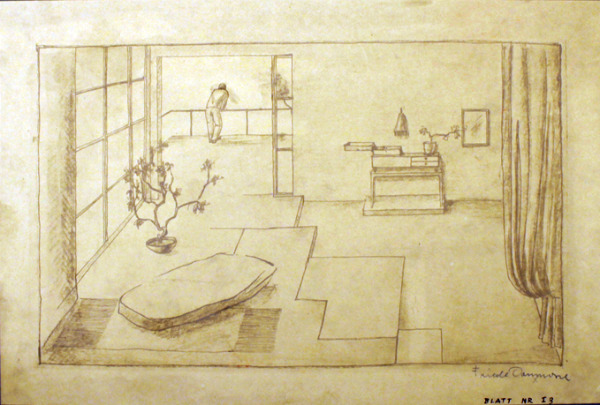
Biography
Friederike Niedermoser, was born as Friedrike Domnosil in Vienna in October 1904. Her father was a civil servant and the family lived in the 3rd district.
At the age of fifteen, from 1919, she attended the Graphische Lehr- und Versuchsanstalt for three years. After graduating, in the fall of 1922, she sat for the entrance examination to the Kunstgewerbeschule (Arts and Crafts School) – and was accepted. Like all new students, she entered the General Department, in Karl Witzmann’s Feneral Form theory class. In this first year of study, she also attended Franz Cizek’s Ornament class and Rudolf Larisch’s minor in Ornamental Lettering and Heraldry. This provided a solid artistic foundation, but Friederike Domnosil had a desire to become an architect. In the enrolment form for the Kunstgewerbeschule, the so-called Nationale (from 1924), under the heading Als Lebensberuf strebe ich an (As a life profession, I aspire to work in) she wrote: ‘Architecture’. She studied for two years in the specialist class for architecture with Professor Oskar Strnad. In her leaving certificate of June 1925, her teacher Strnad wrote as a final assessment:
“Friederike Domnosil a very fine talent; able to form poetically felt things. Artistically independent. Very suitable for all abstract form building. Furniture, house building, appliances, inlays, fabrics.”
In the portfolio of architectural and stage designs of the Strnad School (1926, dedicated to Rudolf Larisch), her project for a beach house on the Old Danube is illustrated with floor plan, wall elevations and interior.
She began to work as a freelance interior designer in the studio of architect Wilhelm Koch. Independently, she participated in several competitions for interiors. Then she met her colleague Otto Niedermoser, who had also studied at the Kunstgewerbeschule and continued his architectural training at the Akademie der bildenden Künste (Academy of Fine Arts). He graduated in 1928 and Friederike and Otto were married in the same year. The family owned the furniture company ‘M. Niedermoser & Söhne’ with an attached upholsterer’s workshop. Founded by Michael Niedermoser, Otto’s grandfather, the business was managed at this time by his father Wilhelm Niedermoser. But Otto’s interests were more in stage design, architecture, and teaching. He was active at the Kunstgewerbeschule, where he took over the class for stage and film design in 1941 and, at the same time, led the master class for furniture construction and interior design from 1949 until his retirement in 1973. Otto Niedermoser was active as an architect and stage designer in Germany and abroad.
Friederike became an employee in her husband’s studio from the time of their marriage. After the death of her father-in-law, in 1934, she managed the furniture company until the last worker was called up in 1941.
Unfortunately, no other works by her are preserved, were not known, or documented.
In 1933, her daughter Gabriele Niedermoser was born. The young woman also embarked on an artistic path. She studied at the (then) Akademie für angewandte Kunst in the master class for stage costume and then moved to the Academy of Fine Arts Vienna. She became active as a costume and stage designer for many Viennese stages, including television. From 1962 she had a teaching position at the Angewandte, in the class for stage costume and costume design. She still lives in the Viennese house with the former workshop of the furniture company and the apartment of the Niedermoser family.
In a telephone conversation, the now elederly Gabriele Niedermoser says that unfortunately there are no remaining works by her mother Friederike. On the occasion of an exhibition for her 90th birthday in 1994, an invitation card with a short curriculum vitae and photo was printed. This she could make available. Her mother and she did a lot of drawing in her father’s studio, on projects for reconstruction housing, competitions, and stage sets. But there was nothing written or signed.
Works (selection)
1926 Design for Strandhaus an der Alten Donau (a beach house on the Old Danube), in the portfolio with architectural and stage designs of the Strnad School, 1926 (dedicated to Rudolf Larisch), UaK archive
1928 – 1941 Collaboration, then management of the furniture company Niedermoser, cabinetmaker’s and upholsterer’s workshop
1928 – 1973 work in the studio of architect Otto Niedermoser
Sources
Nationale Friederike Domnosil, 30.9.1924, Kunstgewerbeschule Wien, Archiv UaK
Friederike Domnosil, Abgangszeugnis vom 30.6.1925, Kunstgewerbeschule Wien, Archiv UaK
Domnosil Friederike Arbeiten an der Kunstgewerbeschule, in: Strnad Schule, Mappe mit Architektur- und Bühnenentwürfen Rudolf Larisch gewidmet, Wien 1926
Sabine Plakolm: Beruf: ‚Frau Architekt‘ Zur Ausbildung der ersten Architektinnen in Wien, in: Margarete Schütte-Lihotzky. Architektur. Politik. Geschlecht. Neue Perspektiven auf Leben und Werk, Hg.: Marcel Bois, Bernadette Reinhold, Basel, 2019, p. 38-51, here p. 42
Einladungskarte zur Ausstellung Friedl Niedermoser, Lucia Kellner „Ein Garten in Klosterneuburg“, Klosterneuburg, 11.8.1994
Photo Portrait: Friederike Niedermoser, 1994, private
Photo: Abgangszeugnis der Kunstgewerbeschule 1925, Archiv UaK
Photo: Interieur, Zeichnung 1926, Archiv UaK
Text: Christine Zwingl
February 2022

